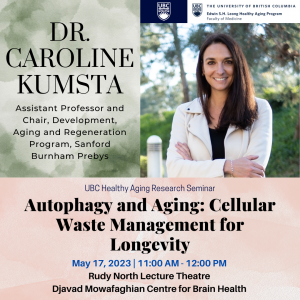Lecture Title: Autophagy and Aging: Cellular Waste Management for Longevity
Summary: Autophagy is a conserved cellular recycling process maintaining cell homeostasis. Macroautophagy involves the sequestration of cytoplasmic contents in a double-membrane organelle referred to as the autophagosome with subsequent degradation of its contents upon delivery to lysosomes. Autophagy is important for health and lifespan and the age-related decline in autophagy has been implicated in the development of age-related diseases including neurodegeneration. Focusing on studies in the nematode Caenorhabditis elegans, Dr. Kumsta will summarize recent advances in our understanding of the role of neuronal autophagy in aging, and highlight her labs efforts in characterizing the regulation of autophagy upon stress and age.
Speaker Biography: Dr. Caroline Kumsta is an Assistant Professor at Sanford Burnham Prebys since 2021 and her research focuses on studying the role of the cellular recycling process autophagy in hormetic stress responses, aging and neurodegeneration using the nematode C. elegans and human tissue culture. She received her Ph.D. from the Technical University in Munich, Germany, and her thesis research was performed at the University of Michigan in the lab of Dr. Ursula Jakob. She joined Sanford Burnham Prebys as a postdoc with Dr. Malene Hansen in 2009; and was then promoted to staff scientist, research assistant professor, and now assistant professor. In addition to her research, Dr. Kumsta is passionate about science education, scientific outreach, mentoring, and cultivating diversity and inclusion in science.
Participants may attend the seminar in-person at the Rudy North Lecture Theatre in the Centre for Brain Health at UBC, or via Zoom. A light lunch will be provided for those attending in person.
Please register here for the seminar.

To join over Zoom:
Zoom Meeting ID: 93567 416276
Step 1: Open https://ubc.zoom.us/ and click on ‘Join a Meeting’.
Step 2: Enter the 11 digit Zoom Meeting ID then click ‘Join.’
Step 3: If you have the Zoom client click ‘Open Zoom Meetings,’ otherwise, click ‘join from your browser.’
Step 4: Enter the last 6 digits of the Zoom Meeting ID in the passcode field, then click ‘Join Meeting.’